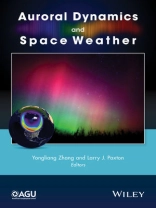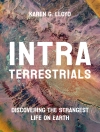The aurora is the most visible manifestation of the connection of the Earth to the space environment and has inspired awe, curiosity, and scientific inquiry for centuries. Recent advances in observing techniques and modeling and theoretical work have revealed new auroral phenomena, provided a better understanding of auroral dynamics, and have led to an enhanced capability for auroral forecasts.
This monograph features discussions of:
* New auroral phenomena due to the ring current ion and polar rain electron precipitation
* Various auroral forms and hemispheric asymmetry
* Auroral model development and MHD simulations
* Application of the auroral observations for radio absorption and scintillation
* Aurora nowcast and forecast for space weather operations
Auroral Dynamics and Space Weather is a valuable contribution for scientists, researchers, space weather operators, and students of Earth’s space environment.
Table des matières
Contributors vii
Preface xi
Part I: Aurora Types and Dynamics 1
1 Investigations of the Many Distinct Types of Auroras
Christopher A Colpitts 3
2 Quasiperiodic Aurora: Outstanding Problems and Recent Results
Eric J Lund 19
3 Inverted?]V Auroral Arcs and Alfvén Waves
Christopher C Chaston 29
4 Auroral Arcs and Ion Outflow
Romain Maggiolo 39
5 Isolated Proton Auroras and Pc1/EMIC Waves at Subauroral Latitudes
Kaori Sakaguchi, Kazuo Shiokawa, Yoshizumi Miyoshi, and Martin Connors 59
6 Dynamics of the Dayside Aurora as Viewed from the South Pole
Donald J Mc Ewen, Gulamabas Gulamhusen Sivjee, and Yongliang Zhang 71
7 Structures in Polar Rain Auroras
Yongliang Zhang, Larry J Paxton, and Hyosub Kil 81
8 Dynamics Related to Plasmasheet Flow Bursts as Revealed from the Aurora
Larry R Lyons, Yukitoshi Nishimura, Beatrice Gallardo?]Lacourt, Ying Zou, Eric F Donovan, Stephen Mende, Vassills Angelopoulos, John M Ruohoniemi, Kathryn A Mc Williams, Don L Hampton, and Michael J Nicolls 95
9 Role of Multiple Atmospheric Reflections in Formation of Electron Distribution Function in the Diffuse Aurora Region
George V Khazanov, Elizabeth W Himwich, Alex Glocer, and David G Sibeck 115
Part II: Hemispheric Conjugacy of Auroras 131
10 Mechanisms that Produce Auroral Asymmetries in Conjugate Hemispheres
Nikolai Østgaard, Jone Peter Reistad, Paul Tenfjord, Karl Magnus Laundal, Kristian Snekvik, Steve Milan, and Stein Haaland 133
11 Interhemispheric Symmetries and Asymmetries of Aurora from Ground?]Based Conjugate Observations
Natsuo Sato, Akira Kadokura, Tetsuo Motoba, Keisuke Hosokawa, Gunnlaugur Björnsson, and Thorsteinn Saemundsson 145
Part III: Substorm Aurora 163
12 Magnetospheric Substorm Onset by Current Disruption Processes
Anthony T Y Lui 165
13 Substorm Auroral Dynamics Reproduced by Advanced Global Magnetosphere.Ionosphere (M-I) Coupling Simulation
Takashi Tanaka 177
Part IV: Radio Aurora 191
14 The Radar Aurora
David L Hysell 193
15 GPS Phase Scintillation at High Latitudes during Two Geomagnetic Storms
Paul Prikryl, Reza Ghoddousi?]Fard, John M Ruohoniemi, and Evan G Thomas 211
16 Radio Absorption in Auroral Region
John K Hargreaves 233
17 Auroral Kilometric Radiation: Polarization and Spectra Observed Far from Earth
Kozo Hashimoto, Yoshitaka Goto, Yoshiya Kasahara, Hiroshi Matsumoto, and Roger R Anderson 255
Part V: Auroral Models and Predictions 275
18 Auroral Precipitation Models and Space Weather
Patrick T Newell, Kan Liou, Yongliang Zhang, Thomas S Sotirelis, Larry J Paxton, and Elizabeth J Mitchell 277
19 Space Weather Products and Tools Used in Auroral Monitoring and Forecasting at CCMC/SWRC
Yihua Zheng and Lutz Rastaetter 291
Index 303
A propos de l’auteur
Dr. Yongliang Zhang is a Senior Scientist at the Applied Physics Laboratory in Johns Hopkins University, Laurel, Maryland, USA. His research focuses on aurora, ionosphere and thermosphere remote sensing based on image intensifier (FUV) measurements. He developed many algorithms for FUV based auroral (precipitating electrons, boundary), thermosphere (O/N2 ratio, NO column density), and ionosphere (TEC) products using image data. These products have been used by the community and resulted in many publications. He discovered new auroral phenomena, such as detached aurora, polar rain aurora, neutral particle aurora, etc. He developed an empirical global auroral model of electron energy flux and mean energy. This auroral model has been used by scientists around the world in their ionosphere/thermosphere simulations and improved their simulation results. The auroral model (equatorward auroral boundary) has been included in the 2012 International Reference Ionosphere. He also developed an empirical auroral model and received a NASA group achievement award in 2008. Dr. Zhang is a member of AGU since 1990, member of COSPAR since 2008, member of AOGS since 2009. He has published a number of papers on new aurora phenomena: ring current and polar rain aurora in some of the eminent AGU journals, JGR and GRL. He received excellent reviewer award for JGR-space physics in 2012.
Dr. Larry J. Paxton is a Principal Scientist and Supervisor for Geospace and Earth Science Group at the Applied Physics Laboratory in Johns Hopkins University in Laurel, Maryland, USA. He is an expert and leader in both scientific research and instrument development in the field of aurora, ionosphere and thermosphere. He has published many scientific and technical papers. He is the PI for DMSP/SSUSI and TIMED/GUVI that is dedicated for the near earth space environment monitoring, including three areas mentioned above. He also serves as a member for many panels and committees including the American Astronomical Society, American Geophysical Union, American Meteorological Society and Sigma Xi. He is now AGU Secretary for Aeronomy. Dr. Paxton has organized over 35 special sessions at American Geophysical Union (AGU) meetings since 2000. Dr. Paxton has been author or co-author on over 250 abstracts at AGU meetings since 2000 and been author or co-author of over 450 presentations at national and international meetings.











